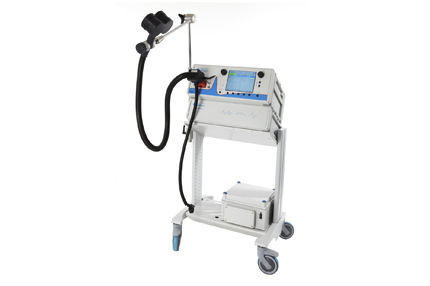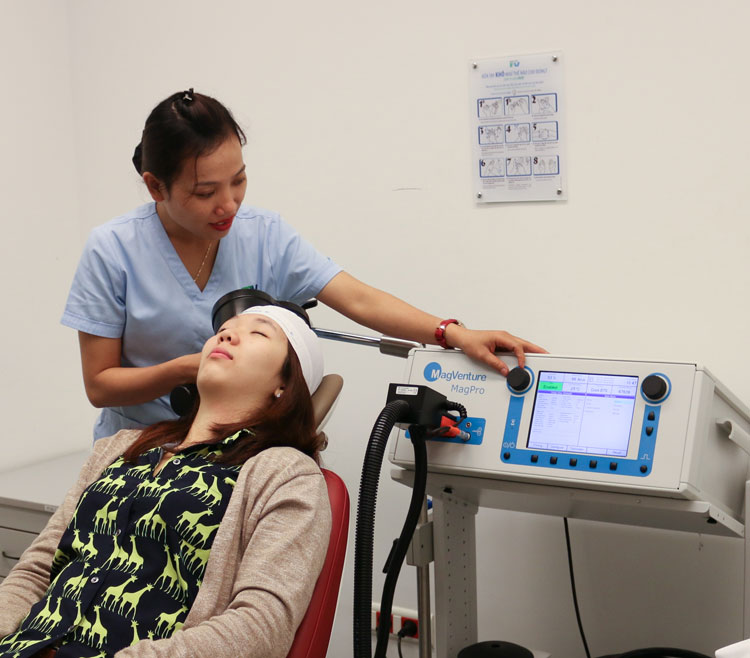WHAT IS REPETITIVE TRANSCRANIAL MAGNETIC STIMULATION (rTMS)?
rTMS is a non-invasive form of brain stimulation therapy. Magnetic fields, generated by a simple coil (a type of electrode) placed on the scalp, are used to stimulate a small area on the surface of the brain. In rTMS, pulses are given repeatedly for therapeutic effect, the objective being to change an “unbalanced brain” to a more normal condition. For the treatment of chronic pain, the area of stimulation is the motor cortex.

WHEN IS rTMS USED?
rTMS has been routinely used since 1985 to treat some forms of severe depression. rTMS treatment of patients with refractory neuropathic pain has been introduced in the 1990’s, then patients suffering from other types of chronic pain such as fibromyalgia, complex regional pain syndrome, low back pain, migraine and other pain syndromes, have benefited from this treatment.
rTMS must be prescribed and monitored by experienced doctors.
WHAT HAPPENS DURING A SESSION?
rTMS is a non-invasive method and you will be awake through the whole session. A session involves lying in a comfortable recliner chair and wearing either ear muffs or plugs for hearing protection. A nurse places the electromagnetic coil on your skull near the area of your brain to be stimulated. When the treatment starts you may hear a soft clicking noise and feel a tapping sensation on your scalp. Each rTMS treatment session takes between 20 and 40 minutes of actual stimulation and then you should be able to resume your normal activities including driving home after the session.
HOW LONG THE TREATMENT LAST?
The treatment starts with one session a day for five days during the first week, then one or three sessions on the following week. The benefit (pain relief) is then evaluated and if satisfactory a second phase is initiated with one session per week for one month, then one session every three weeks for six months. In the absence of improvement, the treatment must be stopped and other protocols can be discussed.

Tell your doctor if:
- You are pregnant or thinking of becoming pregnant;
- You have any metal or implanted medical devices in your body. In some cases, people with metal implants or devices can have rTMS. However, due to the strong magnetic field produced during rTMS, the procedure is not recommended for some people who have the following devices:
- Aneurysm clips or coils
- Stents
- Implanted stimulators
- Implanted vagus nerve or deep brain stimulators
- Implanted electrical devices, such as pacemakers or medication pumps
- Electrodes for monitoring brain activity
- Cochlear implants for hearing
- Any magnetic implants
- Bullet fragments
- Any other metal device or object implanted in your body
- You’re taking any medications, including prescription or over-the-counter medications, herbal supplements, vitamins or other supplements, and the doses;
- You have a history of seizures or a family history of epilepsy;
- You have other mental health disorders, such as substance misuse, bipolar disorder or psychosis;
- You have brain damage from illness or injury, such as a brain tumour, a stroke or a traumatic brain injury;
- You have frequent or severe headaches;
- You have any other medical conditions.
WHAT ARE THE SIDE EFFECTS?
rTMS is usually well tolerated with minimal side-effects. There is no need for any anaesthetic or sedation and there are no adverse effects on memory and thinking ability. Side-effects are infrequent and usually minor: scalp discomfort, facial muscle twitching, mild headache and feeling of light-headedness. Most patients find side-effects reduce in intensity and frequency as the course of rTMS progresses. Though rare, rTMS does come with a small risk of seizures.



